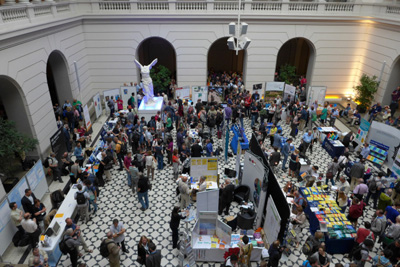
Mathematicians mingle at the ECM at the Technische Universität Berlin. Image from the ECM website.
It's day three of the European Congress of Mathematics in a sunny and hot Berlin, and we've been having fun. The highlights so far include a brilliant talk by Sara Zahedi for whom mathematics, quite literally, acted as a language. Born in Iran, Zahedi came to Sweden aged ten and alone, not speaking a word of Swedish. It was at school in her maths classes, and through the language of maths, that she made her first friends in a strange country.
Zahedi works on the dynamics of fluids; in particular she tries to understand what happens at the interface at which two fluids with different properties meet. An example comes from medicine: scientists are working on chips that could act as mobile labs on which blood samples can be tested, for example for viruses or bacteria. Zahedi's work will help scientists simulate how blood and other fluids interact on those chips. That way, they can model the functioning of such chips on computers before actually making them, saving time and money.
James Maynard from the University of Oxford gave another great talk. Maynard has proved that there are infinitely many prime numbers (numbers only divisible by themselves and 1) which don't have the number 7 as a digit. And he didn't do this just for the fun of it. Prime numbers have fascinated mathematicians for millennia, but some very basic questions (for example if there are infinitely many pairs of prime numbers that are 2 apart) still haven't been answered. Maynard's problem about the digit 7 serves as a test bed for other, more fundamental questions: he hopes that the mathematical tools he has developed will generalise. We interviewed Maynard about a different result last year, and you can read the article here.
Both Maynard and Zahedi have won a prestigious prize awarded by the European Mathematical Society to young researchers not older than 35 years, in recognition of excellent contributions to mathematics.
Another favourite was a talk by Helmut Pottmann of the Technical University of Vienna, about the maths of architecture. Pottmann explained that if you want to build beautiful freeform structures in a way that's not only aesthetically pleasing but also feasible and affordable, you are quickly led into a field of maths called differential geometry. And although architects make much use of digital design tools these days, these tools are not yet specialised enough, and Pottmann thinks that mathematicians will have an important role to play in developing better ones.
Watch this space for more detailed articles on the work of Maynard, Zahedi and Pottmann.
For the rest of today we're looking forward to, amongst other things, talks on the history of mathematics, a women in mathematics reception, and an event of the popularisation of maths. We'll report on those tomorrow.